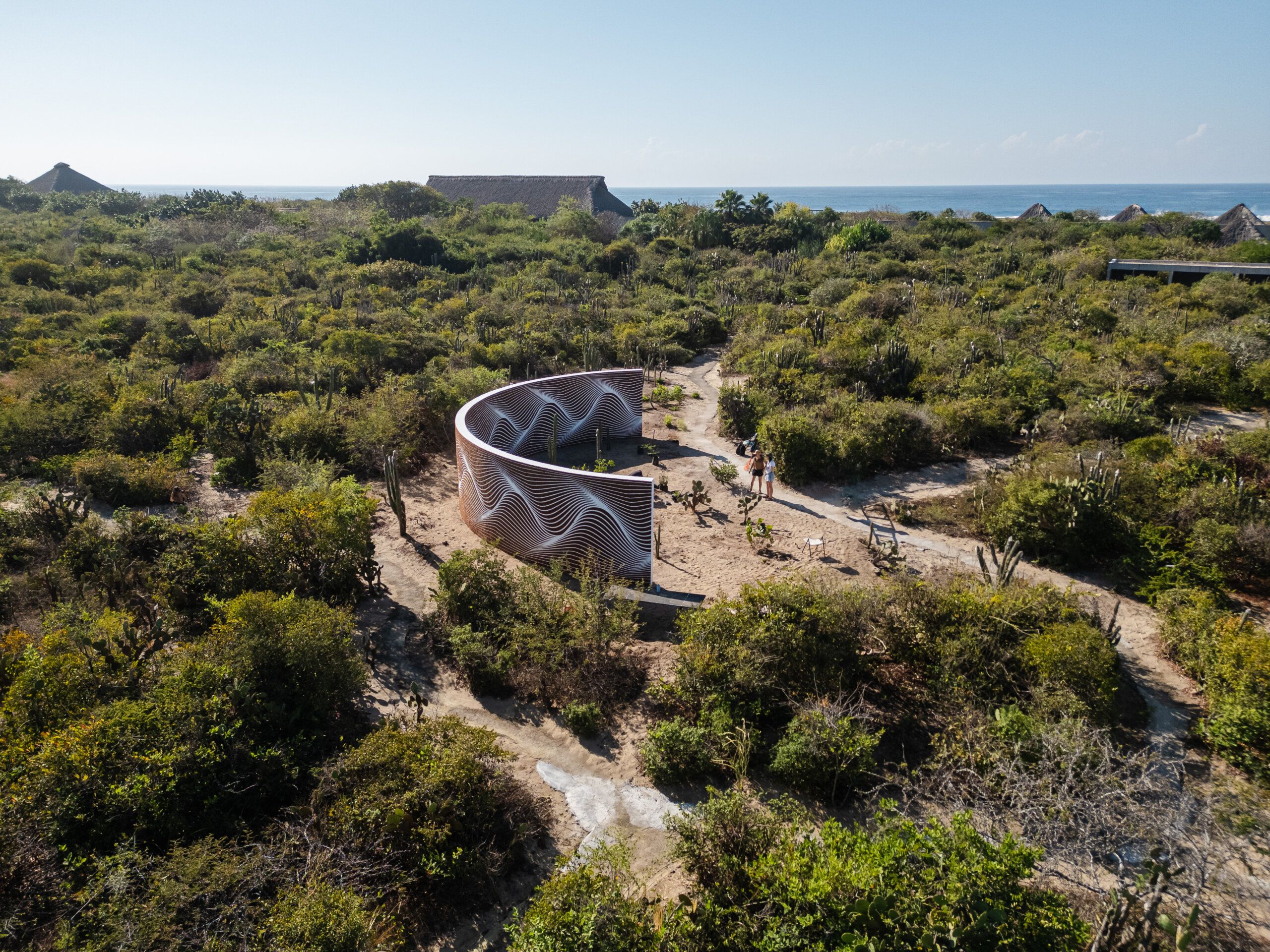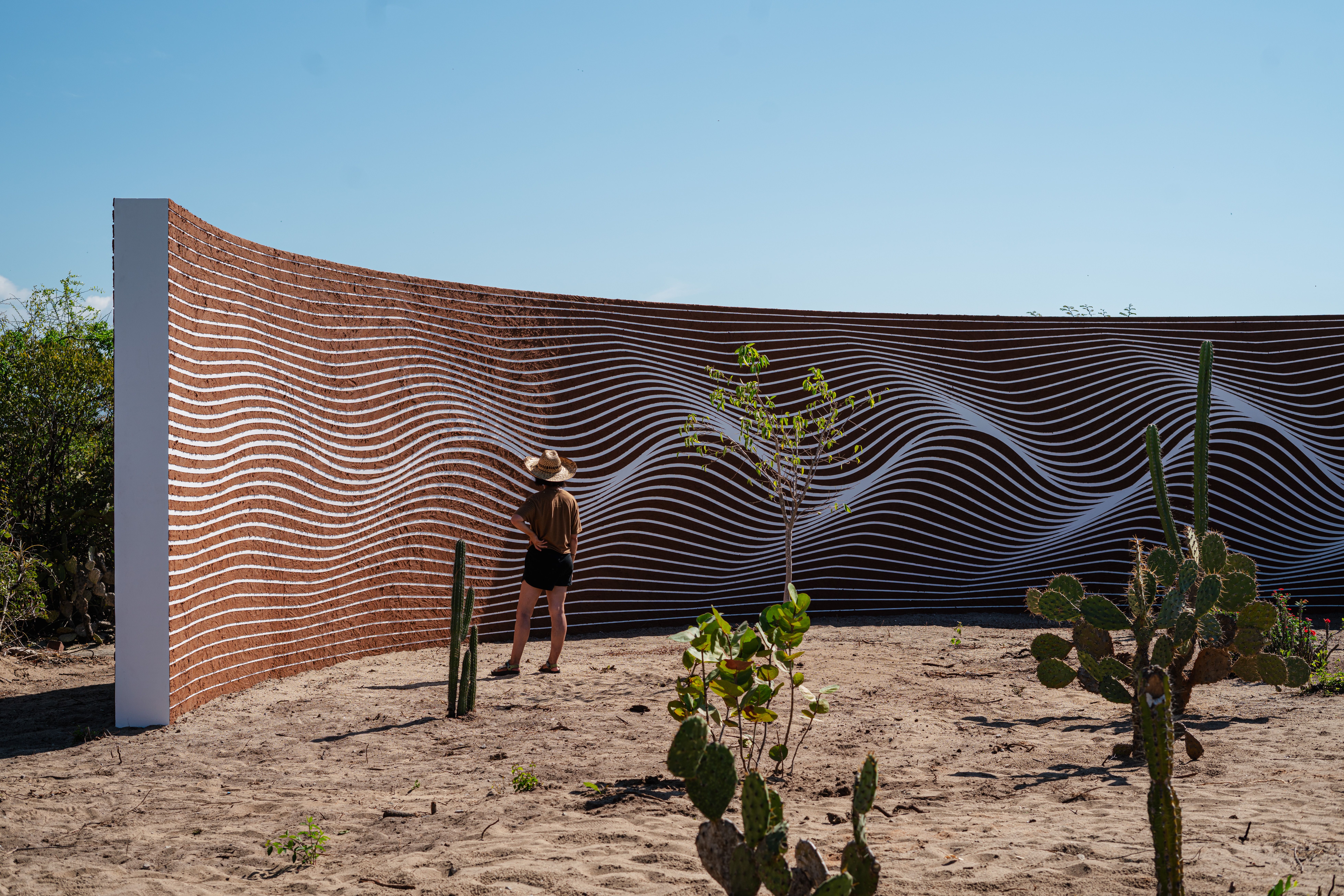From Where We Rise (freestanding wall, soil painting)
Claudia Comte’s From Where We Rise, based on her Casa Wabi exhibition of the same name, may not at first appear to be a work of public protest. Not in the context of more clearly political bodies of work such as her recent series of HAHAHA paintings, with titles like A Plastic Bag Drifting Underwater Over a Coral Reef (hahaha painting) (2022) and A Mother and Child at a Macaque Breeding Facility (hahaha painting) (2022). Those suggest some combination of supervillain glee and the frantic quality of laugh-or-cry despair in the face of calamity. Another recent series of what are essentially funerary reliefs for flora in white Carrara marble (a la Roman sepulcher sculpture) carry titles such as DECREASED RAINFALL LINKED WITH TROPICS DEFORESTATION (2023) and NEARLY A THIRD OF WORLD’S CACTI FACE EXTINCTION, SAYS IUCN (2023).
In contrast to such explicit statements of protest, From Where We Rise looks like something else: more of an experiment in visual perception than social activism. But its subject is the precarity of the human condition. What we see is a landscape of red dunes cresting in an endlessly repeating climax. Fashioned from local soil, it stands in seeming harmony with the hardscrabble but irrepressibly fecund local environment, including the various native plants that Comte intended to be integral to it. But this harmony is an intentionally gorgeous mirage. The insistently accelerating pattern of irregular wave forms on the wall is: a distortion field; a visual klaxon signaling doom; the readout of a terrestrial oscilloscope, with the disordered frequency, cycle, wavelength, amplitude, and phase of these waves showing our existence accelerating towards critical mass.
Of course it is fine to appreciate its beauty; but we should also have the courage to see it for what it is: a kind of futuristic diorama we might imagine having been created to tell the story of the death of the Earth—perhaps for a natural history museum on another planet a million years from now. The visual summary is that humanity is in the process of wave-amplifying the Earth into spinning out of control. We are in danger of turning our glorious garden planet into an uninhabitable desert. As such From Where We Rise should be classified with not Op Art but other citizen-of-the-world, plight-of-humanity monuments such as Isamu Noguchi’s Sculpture to Be Seen From Mars, a vast land art epitaph to humanity that Noguchi proposed in 1949 under the assumption that the dawn of the atomic age signaled the inevitability of our self-annihilation.
The version of the American Southwest and Monument Valley (Arizona/Utah, USA) featured in the Looney Tunes cartoons starring Wile E. Coyote and Road Runner has been cited before as a source for Comte’s landscapes. Which may sound odd bordering on insulting at first, but was intended as serious interpretation. The awesomely composed quality of Comte’s work—as it does in From Where We Rise—tends to mask the purposeful ludicrousness of its manias. Just as the exuberance on display in those cartoons—which regularly veers into a fairly nakedly vicious insanity that we choose, heads buried in the sand, to interpret as mere silliness—camouflages the fact that they are artifacts of the cold war and entirely symptomatic of its psychopathies.
The mindlessly brutal struggle between Wile E. Coyote and Road Runner reflects the fear and anxiety of living under the perpetual threat of imminent nuclear holocaust. The supposedly natural enmity between the two protagonists is satire. The gleeful arms race in which they engage is satire. The absence of any meaningful communication between them besides violence is satire. The landscape they “inhabit,” that of the Manhattan project (the frequent use of miniature mushroom clouds drives home the point), is a harbinger of the post-apocalyptic environmental conditions—nuclear winter covering a global desert—that were/are one of its most likely byproducts. Theirs is a bleak world devoid of sense, in which a bland cruelty mocks the idea of detente and has replaced any shred of humanity. And so is ours. A fact only partially obscured by the still relatively idyllic Oaxacan landscape.
The cold war sort of ended, but we have managed to find new ways to send the world careening towards oblivion—with a solid majority of us abetting its ruin through willful, blind allegiance to our own self interests. The immediate sources of fear have shifted: from nuclear war to climate change, for example. But the sense of impotence and the resultant anxiety have not. Comte’s work seethes with the frustration of our helplessness: to address the overwhelmingly perilous state of things and the seemingly Sisyphean task of doing anything about it with art. A task from which Comte, nevertheless, does not flinch. Her amiable-seeming, bulbous biomorphism is satire. Her dalliances with the appearances and operations of space design are satire. The explicit femininity with which she suffuses her work—luxuriously sensuous material treatments, a general sinuosity, and extreme formal beauty—are satire. She is never anything less than furious at the mess we are making of the world.
And yet, From Where We Rise does offer a glimmer of hope of sorts—beyond the inescapable beauty of nature, even under assault. (The tidal wave that destroys your home is still, on its own formal terms, a sublime thing.) If the world as we know it ends—at the hands of eight billion non-custodial, negligently terracidal human beings—maybe Oaxaca is one place where life, in some form, will take root to rise again.
Dakin Hart
In contrast to such explicit statements of protest, From Where We Rise looks like something else: more of an experiment in visual perception than social activism. But its subject is the precarity of the human condition. What we see is a landscape of red dunes cresting in an endlessly repeating climax. Fashioned from local soil, it stands in seeming harmony with the hardscrabble but irrepressibly fecund local environment, including the various native plants that Comte intended to be integral to it. But this harmony is an intentionally gorgeous mirage. The insistently accelerating pattern of irregular wave forms on the wall is: a distortion field; a visual klaxon signaling doom; the readout of a terrestrial oscilloscope, with the disordered frequency, cycle, wavelength, amplitude, and phase of these waves showing our existence accelerating towards critical mass.
Of course it is fine to appreciate its beauty; but we should also have the courage to see it for what it is: a kind of futuristic diorama we might imagine having been created to tell the story of the death of the Earth—perhaps for a natural history museum on another planet a million years from now. The visual summary is that humanity is in the process of wave-amplifying the Earth into spinning out of control. We are in danger of turning our glorious garden planet into an uninhabitable desert. As such From Where We Rise should be classified with not Op Art but other citizen-of-the-world, plight-of-humanity monuments such as Isamu Noguchi’s Sculpture to Be Seen From Mars, a vast land art epitaph to humanity that Noguchi proposed in 1949 under the assumption that the dawn of the atomic age signaled the inevitability of our self-annihilation.
The version of the American Southwest and Monument Valley (Arizona/Utah, USA) featured in the Looney Tunes cartoons starring Wile E. Coyote and Road Runner has been cited before as a source for Comte’s landscapes. Which may sound odd bordering on insulting at first, but was intended as serious interpretation. The awesomely composed quality of Comte’s work—as it does in From Where We Rise—tends to mask the purposeful ludicrousness of its manias. Just as the exuberance on display in those cartoons—which regularly veers into a fairly nakedly vicious insanity that we choose, heads buried in the sand, to interpret as mere silliness—camouflages the fact that they are artifacts of the cold war and entirely symptomatic of its psychopathies.
The mindlessly brutal struggle between Wile E. Coyote and Road Runner reflects the fear and anxiety of living under the perpetual threat of imminent nuclear holocaust. The supposedly natural enmity between the two protagonists is satire. The gleeful arms race in which they engage is satire. The absence of any meaningful communication between them besides violence is satire. The landscape they “inhabit,” that of the Manhattan project (the frequent use of miniature mushroom clouds drives home the point), is a harbinger of the post-apocalyptic environmental conditions—nuclear winter covering a global desert—that were/are one of its most likely byproducts. Theirs is a bleak world devoid of sense, in which a bland cruelty mocks the idea of detente and has replaced any shred of humanity. And so is ours. A fact only partially obscured by the still relatively idyllic Oaxacan landscape.
The cold war sort of ended, but we have managed to find new ways to send the world careening towards oblivion—with a solid majority of us abetting its ruin through willful, blind allegiance to our own self interests. The immediate sources of fear have shifted: from nuclear war to climate change, for example. But the sense of impotence and the resultant anxiety have not. Comte’s work seethes with the frustration of our helplessness: to address the overwhelmingly perilous state of things and the seemingly Sisyphean task of doing anything about it with art. A task from which Comte, nevertheless, does not flinch. Her amiable-seeming, bulbous biomorphism is satire. Her dalliances with the appearances and operations of space design are satire. The explicit femininity with which she suffuses her work—luxuriously sensuous material treatments, a general sinuosity, and extreme formal beauty—are satire. She is never anything less than furious at the mess we are making of the world.
And yet, From Where We Rise does offer a glimmer of hope of sorts—beyond the inescapable beauty of nature, even under assault. (The tidal wave that destroys your home is still, on its own formal terms, a sublime thing.) If the world as we know it ends—at the hands of eight billion non-custodial, negligently terracidal human beings—maybe Oaxaca is one place where life, in some form, will take root to rise again.
Dakin Hart



